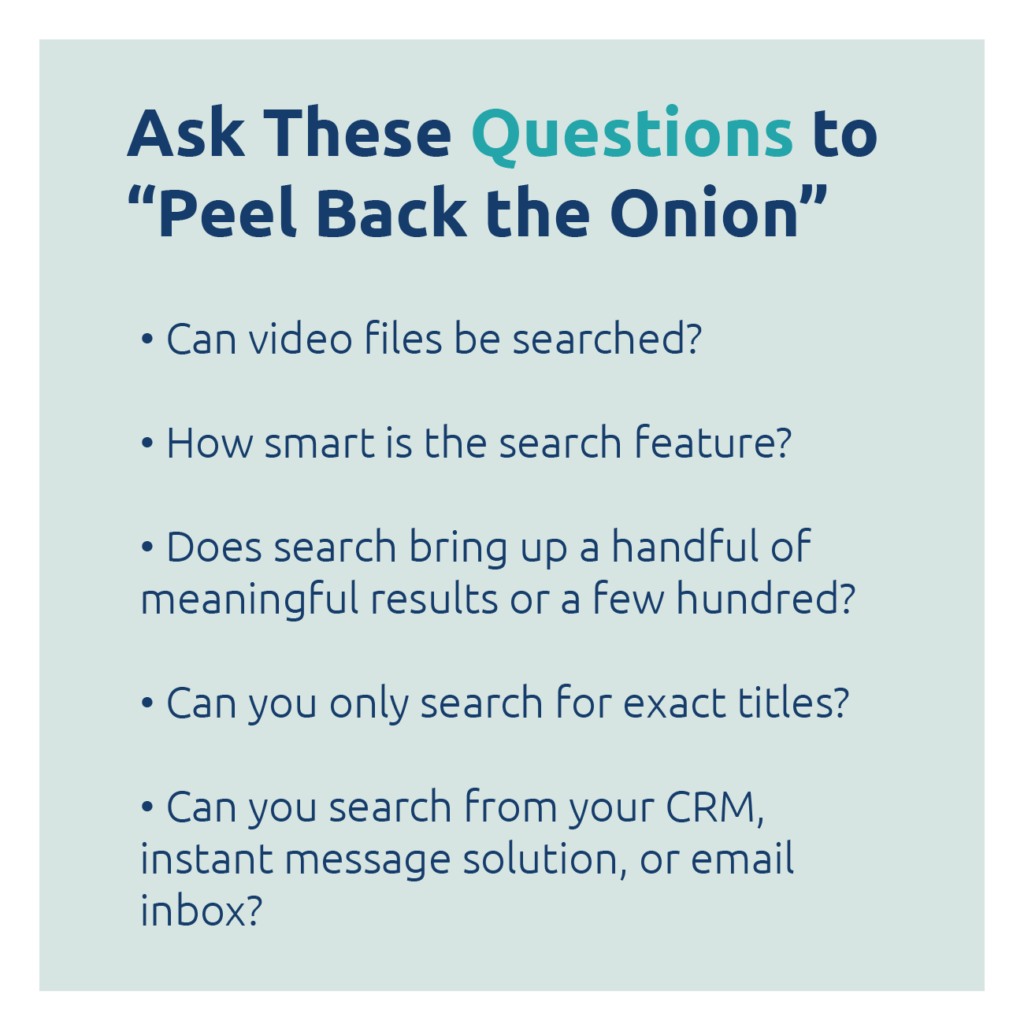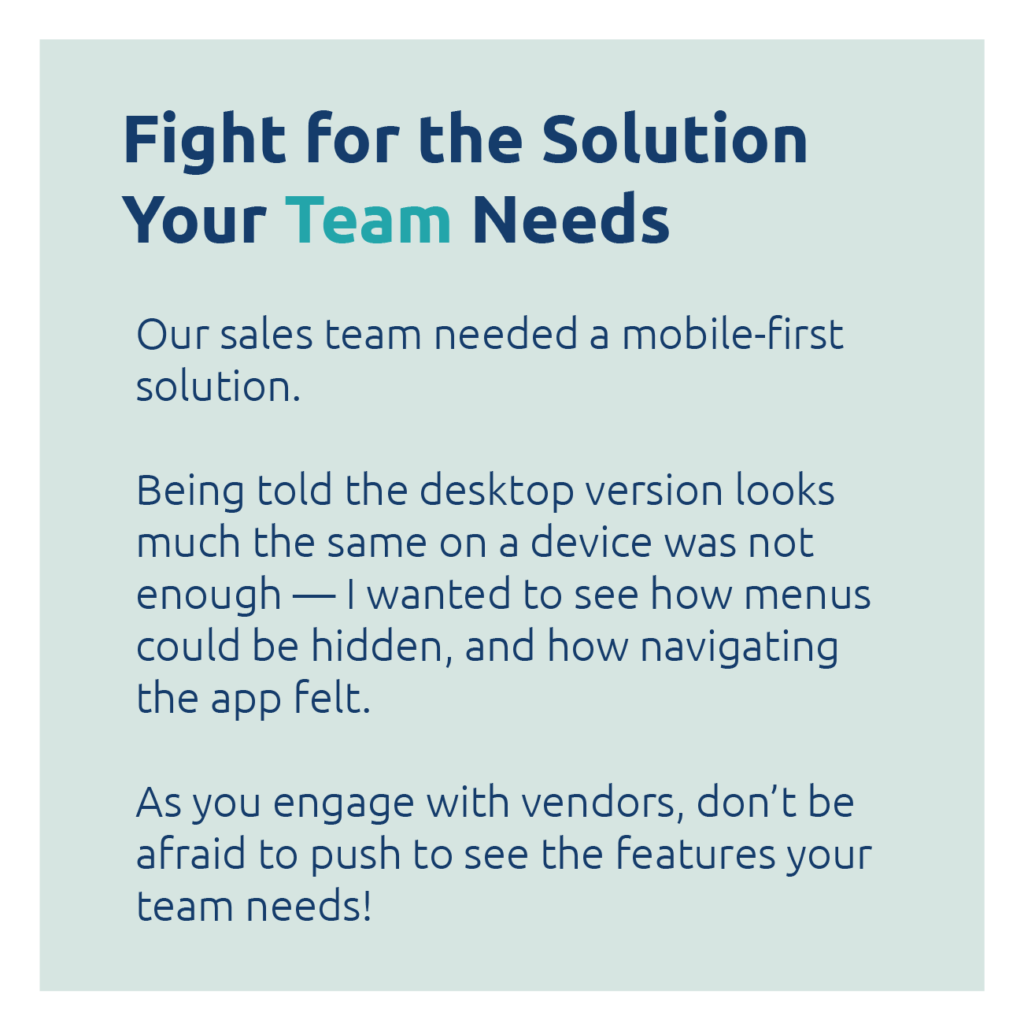Choosing the right sales enablement solution is no easy task – you’ve got to get everyone from sales associates to executives on the same page. With many competing interests, how do you select a solution that your go-to-market teams can’t live without?
First, don’t just walk a mile in your stakeholder’s shoes – prepare to run a marathon. You’ll need a deep understanding of how primary users work, including their challenges and needs. Second, look for technology that supports your enablement program not just today, but well into the future. Here are a few best practices to get started.
Let Your North Star Be Your Team’s Feedback
Engage your leadership, sales, and, if applicable, your service teams early in the selection process. This will help you make decisions with their  pain points in mind – and ultimately ensure you choose a solution they will want to adopt.
pain points in mind – and ultimately ensure you choose a solution they will want to adopt.
At TD Ameritrade Institutional, we embarked on an eight-week listening tour of 64 associates across several sales teams, including frontline sales associates, sales leadership, and supporting teams like sales operations. The findings were extremely valuable, gave us our top use cases, and ultimately guided everything else we did. Here are some helpful tips:
- Connect virtually. You’ll notice things that may not be shared in a phone conversation.
- Record everything. Whether you’re on a call or video conference, conversations can start to blend together, and you’ll want to refer back to these later.
- Consider scope. Take note of the effort and resources required to complete each request you hear. Add a column to your Excel file list, or wherever you are tracking needs, called “resources.” This will help your leadership team better prioritise tasks later on.
- Get the whole story. Interview more than one person from each team to uncover potential sources of misalignment. For instance, I discovered one of leadership’s top-five priorities for sales was actually not in sales’ top-ten priorities. Misalignment like this is very common, so stay alert.
- Walk in users’ shoes. If you don’t have a sales or service background, listen in on prospect and clients calls, or in-person meetings when possible. There’s nothing quite like learning in the field for gaining a powerful perspective into their world. The more you understand their mindset and challenges, the better you’ll be able to understand what they share.
- Buffer your calendar with extra time. Don’t be surprised if someone not on your original list wants to share their thoughts. About one in five of our interviews were not planned. Embrace their willingness to share. You’ll likely learn something new.
Once you have gathered all of your feedback, meet with your leadership team to prioritise the long list of solution asks – this will ensure everyone is aligned on priorities before you continue.
Take Time to Understand the Enablement Space
While Google is a good starting point, you’ll find more substantive information in analyst reports. Analyst research will paint a picture of the current market offerings. Previous Waves, Magic Quadrants, and Market Guides can reveal a provider’s pace of innovation – something that is essential to future-proofing your sales enablement purchase. Now, more than ever, you need to delve deeper to get the big picture:
- Don’t discount the value of older reports. Read as far back as you can to uncover trends. A provider who previously received an average rank but climbs higher year over year is clearly committed to evolving its product. Also, see who has been acquiring – these businesses are generally laser-focused on integrating separate technologies, not building native improvements.
- Check out industry awards and special recognitions. Read through awards and industry publications to learn about the big players. But also watch for new or smaller players not found in the reports. For example, I found two tech providers that are now leading enablement platforms. You’ll want to consider all of your options.
By now, your search should be feeling less overwhelming. Not only will you know what your teams need, but you’ll have an initial understanding of the enablement tech landscape.
Seek Out Your “Twins”
Find your “twins” and look for enterprises that are “fraternal” – those that are similar in size and structure to your own. I met firms from other verticals whose frontline teams had similar needs, and hearing about their experiences helped validate some of what I was thinking and further opened my eyes to other more critical considerations. After twinning, I was able to start narrowing my list of options. This was the most transformational part of my journey! Assuming you have at least one potential match, here are some considerations for who to contact:
- Look for other matching firms within your same family of industries. This is your chance to dive deep. Because these “twins” have similar needs as your firm, they can speak to the technical aspects of their experience as it relates to your industry. Ask about everything from vendor onboarding, to integration support, to technical feature capabilities.
- Search for firms with similar tech stacks. These “twins” will be able to confirm whether or not a sales enablement platform will work within your existing tech stack. For instance, we wanted our current training and coaching solution content to be viewable in the new enablement platform. The training and coaching application provider connected us with a “twin” who showed us how this application integrated with a platform already on our short list. Seeing both systems working together seamlessly put my mind at ease knowing that this would be a great value add for our sales team.
Engage with the Innovators You’ve Researched
 Hopefully, several providers have survived your rigorous evaluation. You should now have a more holistic view of enablement solutions and be ready to engage with vendors. Have your top use cases on-hand to share along with any specific needs – these items will help guide your vendor conversation and keep you focused on top priorities.
Hopefully, several providers have survived your rigorous evaluation. You should now have a more holistic view of enablement solutions and be ready to engage with vendors. Have your top use cases on-hand to share along with any specific needs – these items will help guide your vendor conversation and keep you focused on top priorities.
- Expect some repetition. In the beginning, almost all enablement providers will sound the same. There are certain buzzwords they use and capabilities they all mention. And that’s okay. Stay engaged until the second or third call – as they talk through and show you the use cases you have shared, you’ll start to notice how they differ. Let your prioritised use case list guide the conversation and any demos.
- Keep peeling back the onion if it feels like a sea of sameness. As you go deeper, ask more probing questions to “peel back the onion” on features that may at first glance seem the same. Something as straightforward as the ability to search for content is not the same on each platform.
- Multi-integration workflows will help differentiate. Platforms started to feel very different
 after we went through our second use case. I wanted our sales team to be able to send an email to a prospect or client and include content, note that activity in the CRM, and track it on a mobile device. As I watched the number of clicks, screen changes, and intuitiveness of the user interface, the obvious was in front of me. This workflow felt quick and worked seamlessly on some platforms, but clunky and disjointed on others. My list of top four platforms suddenly narrowed down to two.
after we went through our second use case. I wanted our sales team to be able to send an email to a prospect or client and include content, note that activity in the CRM, and track it on a mobile device. As I watched the number of clicks, screen changes, and intuitiveness of the user interface, the obvious was in front of me. This workflow felt quick and worked seamlessly on some platforms, but clunky and disjointed on others. My list of top four platforms suddenly narrowed down to two. - Notice the little things. Is the vendor salesperson having a discussion with you, or going through their agenda? Don’t get blinded by features that are not going to satisfy the use cases from your frontline teams. A family of six needs a minivan – not a Ferrari. Steer the conversation back to your use cases and needs.
- “You had me at AI.” If you are keeping the future needs of your teams in mind, AI is a must-have. The predictive analytics capabilities that some platforms have can help you drive desired sales behaviours in a more scalable way. In turn, this helps fuel revenue growth. If a provider mentions AI, make sure you get a very good understanding of what it actually means and how your teams will benefit from it. For us, it was a critical capability that swayed our decision on which platform to buy. It essentially future-proofed our decision.
Choose a Partner, Not Just a Provider
After participating in many demos with your list of potential providers, you should have narrowed down your choices. When making your final decision, return to your prioritised list and ask yourself:
- Which vendor will scale with me? In my case, the provider that could deliver on sales needs that were 18 months to two years out was impressive, and their AI capabilities gave them the edge. These features were important to us – we wanted a solution that would last.
- Which vendor will fight for us? The willingness of the team to jump into the trenches with us was so important. With the amount of integrations and security requirements, we knew challenges would be inevitable. Make sure your provider’s support experience is as good as their sales experience.
With these elements in mind, you’re ready to make your final decision and begin your journey to sales enablement success – with a platform your teams are sure to love.
Finding Your Forever Solution
No matter the size of your organisation, this process works. It empowers you to feel confident in your research and peer feedback to select a solution that truly drives business success. To learn more, join me at my Forrester Summit session on May 5th, at 11:20 AM EST. I’ll be sharing my story, best practices, and more – I look forward to helping you kickstart your journey to a winning sales enablement purchase.




